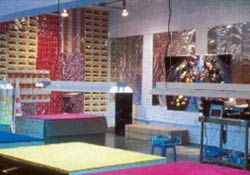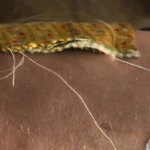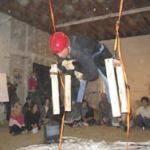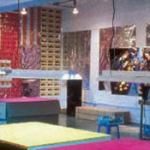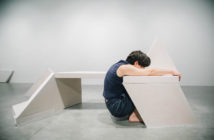Scenario # 2: a university museum, tucked up on a little hill. Inside, brightly colored plastic beach toys are being sold off to the very loud sounds of Asian techno-pop. Red Bull is being served in little cups, and, again, every step offers itself to me as my own little performance-event, but this time I am navigating the pokes and prods of museum goers as they reach for plastic tools and toys, all being sold for 1$. This is, Minimal Factory (1$ Market)/Red Bull Party (with DJ), produced for the Rose Art Museum, and artist Surasi Kusolwong’s latest in a series of 'Everything-the-Same-Price' performance event installations.
Back to scenario #1: Of the six set pieces (Jeff Huckleberry/Jamie McMurry/Joshua Hydeman/ Carissa Trenholm & Nicole Margareten /Gear T.E.K./ /Helen Pfan) and two durational works (Juniper Perlis/ Rose Hill) offered at TEST, I want to invoke only three. First: Jeff Huckleberry, in a parodic and wryly heart-wrenching piece (“High School Was Great”), dressed himself in homemade cowboy gear, and, after rigging a loosely strung, absurdly disjointed sawhorse a good 5 feet from the ground, attempted repeatedly to mount it and retain his balance. As he did this, two audience members pulled on its strings as hard as they could. Here, as with many of Huckleberry’s pieces, we were catapulted into in a gadget-rife comédie-pathètique, oscillating between virility, impotence, desire, frustration, exhaustion and laughter. Second: recalling one of William Pope L.’s city crawls turned in upon itself, Juniper Perlis spent the entire night (6 hours) eyes closed and on her belly, making her way, inch by inch, through legs and around corners. Her tentative arms, reaching for shin, boot, coat and wall, highlighted not only the endurance of her action, but its intimacy and vulnerability. No Pope L-like balloons to signal her performance, she infiltrated our viewing experience throughout the night, reminding us of our own bodies at just the moment we might be tempted to forget them in the spectacle. Finally: Jamie McMurry’s performance, basting mid-sized quilt patches onto his bare legs, bloodying his fingertips on an electric sander and submerging himself in an elevated water tank which he then destroyed, surprisingly, also suggested something of both the delicate and the heart-wrenching. In gently basting his grandmother’s quilt to one leg, then the other, we watched the tropes of invasive body art (the body as a site of metaphor and contestation) being re-articulated as disconcertingly poignant eulogy.
The Kusolwong exhibition, on the other hand (scenario #2), suggested not so much the eulogy as the memorial—a memorial organized around culturally coded detritus. The walls, messily papered with patches of different food and candy wrappers, all shiny, distinctly foreign, contributed to an overriding sense of absurd pastiche. In its forms and traces, the exhibition almost suggests the invested speed and ingenuity of a mid-nineties London rave site (bright light of the morning after showing the staples in what glowed seamlessly the night before.) That said, whether, upon entering the scene, one reads the wall text or not, we are clearly being engaged in a missed encounter. And in this missed encounter we are left to reconstruct the opening night event: an ethno-kitsch, nouveau-orientalist encounter between ‘western’ consumerism and the art market place. (The opening featured the artist as DJ/VJ selling a visual cacophony of plastic objects, all homogenized before the universal-equivalent: the dollar form.) Having missed the exchange of plastic dollar store consumables, we now structure our viewing experience around its memory.
In the aftermath of these two events (Kusolwong at the Rose/TEST at Andrews Square), I am led to ask a question. The question has to do with the status of performance art that, together, they suggest. At one end of the spectrum Kusolwong offers a turn from the performance to its remnant—a performance that seems to exist almost exclusively in service the installation-as-memorial. At the other, the TEST event suggests a turn to a kind of body-based work in which the tropes of ‘masochistic’ performance, and its seeming valorization of ontological presence, are not quite taken at face value, yet nor are they entirely eschewed. An implicated position is offered, but not as access to a ‘real’ of the performance event or of the art object, or even of institutional critique. Instead, both performance models seem to circulate both ambiguously and ambivalently around both the earnest and the parodic... perhaps suggesting a structural ambi-valence that is just that: vigorously caught 'between.'
- A detail of Jamie McMurry at TEST.
- Jeff Huckleberry at TEST (photo by Deewayne Sowels).
- Installation view of Surasi Kusolwong at the Rose.
----
Links:
Jamie McMurry
Rose Art Museum
Surasi Kusolwong is on display in The Mildred S. Lee Gallery at the Rose Museum of Art, Brandeis University from January 21 - March 28, 2004.
The TEST event was Feb 27 at Andrews Square Studio near the Andrews T station.
All images are courtesy of the Rose Museum unless otherwise noted.
Natalie Loveless is a regular contributor to Big, Red and Shiny.

